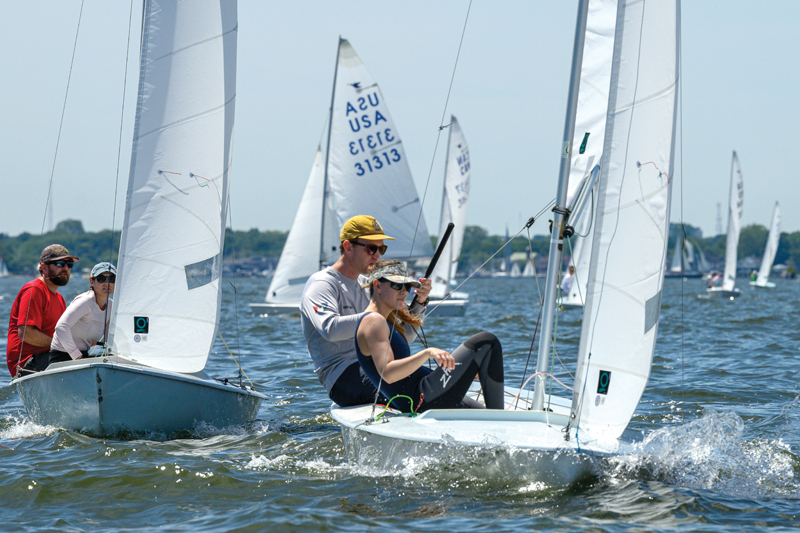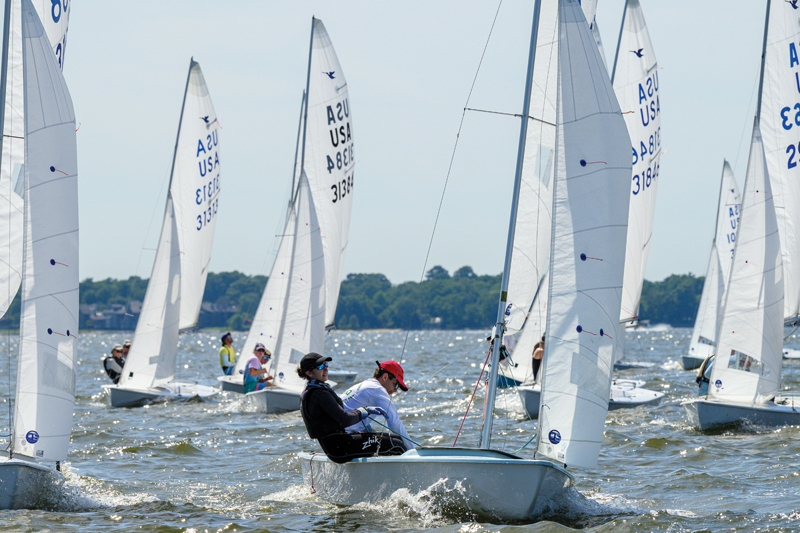Dinghy racing can be complex. Sometimes it can help to dial it down a notch.
From trying to decide which rig setting to go with to figuring out whether or not you might get a lee-bow effect from the current, dinghy racing can be pretty mindboggling. In addition, yes, at the highest levels of the sport, you need to nail each one of those decisions to win.

However, taking a deep breath and making sure that you’re not unnecessarily overcomplicating things can not only be a big relief, but can be a way to do pretty darn well, too. Focusing on a few key things can be helpful for newer racers, who are learning to digest the vast amount of information and decision-making involved in sailboat racing. It can also be key for experienced racers who have gotten themselves all spun up and are overthinking things.
So, let’s dial it back a notch. Let the answers to a few questions calm your mind and clear your brain so that you can focus on some of the elemental parts of racing.
Where am I?
Literally, where are you on the racecourse and what are you dealing with? Are you two-thirds of the way up the weather beat, on the right side, having a hard time finding a clean lane? Are you heading downwind, getting toward the layline for the gates, but probably not quite there because of strong current? Defining where you are and what you’re dealing with can bring some clarity to your thinking and help you decide your next steps.

Where am I going?
Once you know where you are, you can figure out where you’re going. This question lets you add in a little extra layer of analysis: Are you on the tack that’s closest to the weather mark? (Spoiler alert: that’s probably a good idea, unless there’s a good reason to be eating a header.) Are you working to stay inside at a leeward mark rounding? Also check out how you are sailing relative to boats near you (in the same wind field): Are you sailing higher and slower, or lower and faster? Declaring your intentions for where you want and need to go helps you get there, too.
Am I going as fast as I can?
If something doesn’t look or feel right, it’s probably not right. Find a flat spot and divert your gaze from navigating through any chop to check out your sails. Do they look right? Chances are, if they don’t have a nice shape to them, they’re not working effectively. Trust your judgement and adjust your control lines as needed. Do they feel right? Same thing goes here—if you’re not at least in the same speed ballpark as your neighbors on the racecourse, change something!
Is anything going to change—dramatically—soon?
This is primarily a weather-focused question. Because you did your homework (right?) and reviewed the weather forecast for the day, you can take a moment to consider whether any big changes in sailing conditions are coming soon. The forecast may have been for a slow right shift for the wind over the course of the day, and there aren’t any dramatically different clouds appearing overhead. That might equate to only a degree or two over the course of a 20-minute weather leg. In an ideal world, you’d like to take advantage of that subtle shift. But maybe you’re constrained by traffic, and you just can’t get there in a clean enough lane. You might be able to overcome the effects of that shift in other ways, so it’s not the end of the world. But if the forecast is for pop-up thunderstorms, and there’s a big dark cloud developing quickly off to one side of the racecourse, you can expect some more dramatic changes.
Am I and my crew physically set up for success?
If you are not well hydrated and have enough fuel in your belly, you’re giving away good boat handling and good decisions. The effects of a hungry tummy are fairly obvious: weakness, muscle fatigue, and grumpiness, which is especially bad on a multiperson boat. The effects of dehydration are more subtle but potentially can have a bigger effect on your performance: slower reaction times, having a hard time focusing, a general “brain fog.” And these effects can happen when you’re only down one or two percent of your body’s water stores. So, be honest with yourself—when was the last time you ate, and when was the last time you peed? Keep yourself topped up for peak performance.
It’s very hard to take a step back to think clearly about where you are and where you need to be. Focus on answering these five questions to help distill all the data flooding into your head into some actionable information.
By Kim Couranz
About the Author: SpinSheet Small Boat columnist for more than a dozen years, Kim Couranz has earned several national and world titles in Laser Radials (ILCA 6), Snipes, and Lightnings. She has also raced J/22s, J/24s, and Ynglings on an international level.




